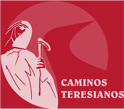
I live without living in me and I look for such an exalted life that I am dying because I am not dead..
There is hardly need for introduction for the woman who, for many, is the most outstanding Spanish writer or, at least, the most important mystic writer. Founder of the Order of the Barefoot Carmelites, with almost twenty convents, Ávila is deeply impregnated with the figure of this nun. So much so that she is referred to as La Santa and is the patron saint of the town; her feast day is celebrated on 15 October.
Teresa de Cepeda y Ahumada was born to a wealthy family in the town. Much has been written about the fact that her family was one of converted Jews and it is possibly true. This caused problems for Teresa during the persecution of those who were not old Christians.
Her childhood in the town marked the two intertwined roads her life was to follow. On the one hand, her religious side appeared at an early age and she had no doubt that she would dedicate her life to worshipping God. On the other, her interest in literature, as an untiring reader of the adventure books that fell into her hands and, later, as a writer herself.
In view of her father’s opposition, she ran away from home and joined the Convent of La Encarnación in 1534. Bad health and realising that monastic life was not what she thought made her reconsider her decision, but she finally chose to continue. What actually drove her on was the idea of founding a convent in which the precepts of asceticism would be observed, such as the obligation to poverty, solitude and silence. She collected funds and, in 1562, opened the Convent of San José (which continues her mission today). However, in 1567, it was not acknowledged and her doctrines of reform received much opposition.
From then on, supported by John of the Cross, who did the same by founding the Order of the Barefoot Carmelite Monks, her order and the precepts of austerity, fasting and prayer spread across the peninsula and clashed with the wealth and political protagonism of the Church.
Until her death in Alba de Tormes, the rest of her life was an array of journeys to found convents and monasteries that usually took her back to her beloved Ávila. It is here where she wrote some of her most important works. Her writings have made her a poetess, thanks to her religious-lyrical poetry, and they have been studied and assessed in many ways. However, they have always stood out because they are not transcriptions or adaptations of sacred texts, which was the most common form of writing at the time, but rather original texts, with their own style, laden with spontaneity and feeling rather than literary archetypes.














